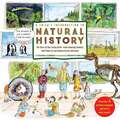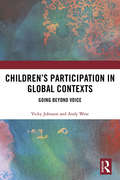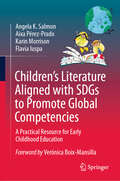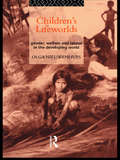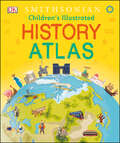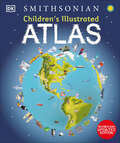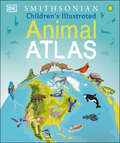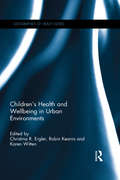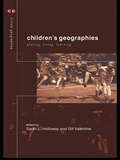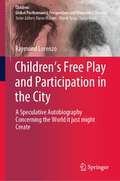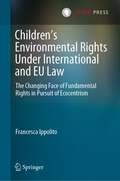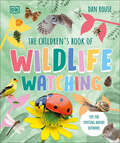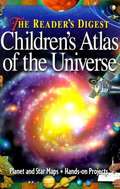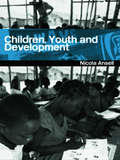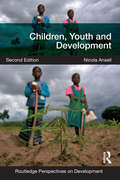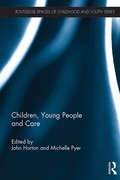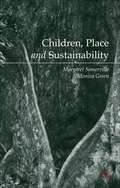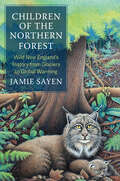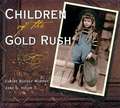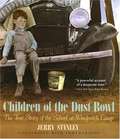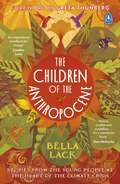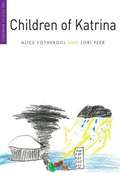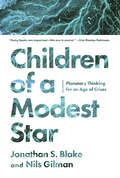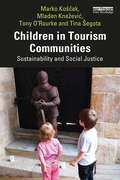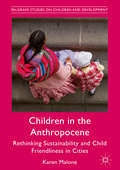- Table View
- List View
A Child's Introduction To Natural History: The Story Of Our Living Earth-from Amazing Animals And Plants To Fascinating Fossils And Gems (A\child's Introduction Ser.)
by Heather Alexander Meredith HamiltonIn the tradition of Black Dog's best-selling Child's Introduction books, which include The Story ofthe Orchestra and A Child's Introduction to the Night Sky, A Child's Introduction to Natural History introduces readers ages 8 to 12 to the fascinating wonders of our natural world. Highlighting every kingdom of life--plants, bacteria, mammals, birds, amphibians, insects, rocks and minerals--the book is also full of charming and witty illustrations by Meredith Hamilton plus 30 photographs throughout. The book delves into topics like geology; prehistoric times, including fossils and dinosaurs; how animals move and fly; evolution; biomes; and more. Sidebars throughout offer biographies of naturalists like Charles Darwin, Mary Anning, and Charles Henry Turner. Also includes fun, hands-on projects for kids to do on their own or with adults and 5 origami patterns to create your own paper fox, whale, penguin, and more. Beautifully illustrated and designed, this is an entertaining and educational look at our natural history.
Children’s Participation in Global Contexts: Going Beyond Voice
by Vicky Johnson Andy WestChildren's and young people’s right to participate has been increasingly acknowledged and taken up internationally, as expressed in the UN Convention on the Rights of the Child. Yet much of this has focused on collecting children’s voices, rather than achieving change, and has met its limits. This book provides an analysis of children’s participation in formal, collective and action research processes in six different international settings. It offers a deeper understanding of what helps and facilitates children's and young people’s participation through research, evaluation and decision-making to go beyond voice and effect change. This analysis is set in the context of historical and current discourses of participation, the sociology of childhood, contemporary anthropology, children’s geography and international development. Themes addressed include time and processes in children’s participation, shifting and multiple identities of children, political and cultural contexts, places and spaces children inhabit, skills and capacities of adults, accountability and power. The analysis promotes an approach to children’s participation as relational and collaborative, and will contribute to answering some of the questions facing practitioners and researchers embarking on participatory enquiry with children and young people. This is an invaluable book for practitioners and for scholars, postgraduates in anthropology, sociology, human geography, childhood studies, development studies, social policy, social work, community work, education, youth work and those with an interest in citizenship, children’s rights and human rights. Researchers and practitioners in UN, government and non-government services will also find it applicable to engaging with children and young people.
Children’s Literature Aligned with SDGs to Promote Global Competencies: A Practical Resource for Early Childhood Education
by Angela K. Salmon Aixa Pérez-Prado Karin Morrison Flavia IuspaThis book presents children’s literature as a platform for learning and helping young readers develop the knowledge, skills, and attitudes needed to thrive in an interconnected and diverse global society. It draws from various theoretical frameworks and research findings to implement critical literacy and culturally responsive teaching in the meaning-making process.The book focuses on global competencies and Sustainable Development Goals (SDGs) as intertwined concepts that work together to foster a more sustainable, inclusive, and equitable world. Developing global competencies empowers children and communities to actively participate in achieving the SDGs and addressing the pressing challenges of our time. The authors set high expectations on children as actors in transforming society. To facilitate this, the book offers an overview of child development theories as a foundation for designing developmentally appropriate practices to extend children’s books toward deep thinking and understanding. The book includes sample lessons that use cutting-edge research-based pedagogies and tools such as visible thinking routines and other approaches. Those lessons also help readers identify the Habits of Mind (HOM) children can develop by listening to and discussing stories. The HOM are attributes of good problem-finders and problem-solvers needed when confronting complex issues. The book provides resources and sample lessons that implement different thinking strategies to engage children in questioning and analyzing what they read, making them more critical. This is how children deeply understand the world and their role in creating positive change. The book aims to cultivate change-makers and global citizens through stories. It offers innovative approaches, including online learning options in accessible and engaging ways to help children think globally and act locally‘Through the power of children’s literature, this book serves a larger agenda: To build a more thoughtful world for future generations. By caring for and learning from one another through suggested activities in this book, they will share the riches and resources from across the world. As children learn about the promise of actions toward the UN Sustainable Goals, they can imagine living in an interdependent learning community where all people continually searching for ways to trust each other, learn together, and grow toward greater intelligence.’ Arthur Costa and Bena Kallick, Co-Founders and Directors of The Institute for Habits of Mind
Children's Lifeworlds: Gender, Welfare and Labour in the Developing World
by Olga NieuwenhuysChildren's Lifeworlds examines how working children face the challenge of having to combine work with school in Kerala. Moving beyond the usual concern with child labour and welfare to a critical assessment of the daily work routine of children, this book questions how class and kinship, gender and household organization, state ideology and education influence and conceal the lives of children in developing countries. Presenting an extraordinarily sympathetic and detailed case study of boys' and girls' work routine in a south Indian village, this book shows children creating the visibility of their work. The combination of personal experience, quantitative data and in-depth anthropological methods, sheds light on the world of those who, though they hold the future, have been left in the dark.
Children's Illustrated History Atlas (Children's Illustrated Atlas)
by DKLearn about incredible world history in this first-ever history atlas for children ages 7-9.Young history buffs will love this time-traveling adventure! This beautiful history atlas helps children learn about world history, all the way from the first humans leaving Africa right up to how the world looks now, with a modern world map. Journey around the world as you learn its history, with maps showing everything from the awe-inspiring Great Wall of China to the when and how of the Civil War.This amazing illustrated atlas brings history to life. It is packed with more than 40 colorful historical maps and fascinating nuggets of information about our past. Children are shown how to read a map and how to use a key, compass, and scale. Each map is bursting with information, such as how big the Roman Empire was, how explorers made incredible journeys around the world, and when humans first traveled into space. This charming and informative history atlas is a key addition to every child's library.
Children's Illustrated Atlas: Revised and Updated Edition (Children's Illustrated Atlas)
by DKA picture atlas that takes young readers on a visual journey around the world, from Spain and Portugal to China and Mongolia.Continents and countries are brought to life through stunning photography and eye-catching illustrations. Uncover incredible geographical features, wildlife, culture, history, and landmarks in unprecedented detail.This incredible and inspiring visual atlas takes you on a fact-filled, continent-by-continent tour of the world. Throughout the pages of this adventure book, you&’ll discover more than 50 fascinating maps packed with fun facts and fresh images. Your child will learn all about the climate, populations, places, and industries of our world. Picture stories complement the maps, from the giant Amazon River flowing through the rainforest to the frozen icebergs of the glacial Arctic. Discover the richness and diversity of human and animal life around the globe. Each map shows countries with their capitals, famous landmarks, longest rivers, and highest mountains.This educational book is more than an atlas! It also shows young explorers how to read a map and use a key, compass, and scale. It&’s the ideal resource for classroom use, home learning, and armchair exploration.The Ultimate Round-The-World Trip.Children's Illustrated Atlas is the perfect reference book for kids to learn about lands close to home or oceans far away! It&’s also a fantastic gift for children with an interest in the world around them and a taste for adventure.Without even leaving your home, this children&’s atlas book allows you to:• Explore more than 50 stunning world maps and incredible geographical features.• Learn how to read a map and use a key, compass, and scale.• Travel the world's cities and landmarks through beautiful photography and illustrations.• Dive into intriguing facts about the world's population.Complete the Series:Charming and informative, the Children's Illustrated Atlas series from DK Books is a delightful addition to every child's library. Bring the amazing world of wildlife right into your home with the Children's Illustrated Animal Atlas and reach into the past with the Children's Illustrated History Atlas.
Children's Illustrated Animal Atlas (Children's Illustrated Atlas)
by DKBring the amazing animal kingdom right into your home! Packed with fun facts about animals and more than 40 full-color maps that detail the countries where they live.This fabulous educational book for kids zooms-in on countries and continents to show key animal habitats and locations around the world. A thrilling animal adventure around the globe, perfect for kids ages 6–8.Each colorful map in this children's book is bursting with animal facts, combining illustrations with gorgeous photographs that highlight each continent's most iconic animals. From the tallest mountains and desolate deserts to wild grasslands and tropical rain forests; it covers key habitats and locations for each country.Packed with tons of fun facts and figures, the Children's Illustrated Animal Atlas explains where these hidden habitats are found and what the local climate is like. Find descriptions and illustrations of the plants and animals that live in them, making the information easy for kids to comprehend.This children's atlas also includes a super awesome, colorful world map pull-out poster showing every corner of the world and animals that live in each country. Through this educational atlas, children are shown how to read a map, use a map key, follow a compass, and how to judge scale and distance.Charming and informative, this kids' atlas is a delightful addition to every child's library.Take A Thrilling Animal Adventure Around The Globe!An enchanting atlas, packed full of fascinating facts and more than 600 incredible animals. From polar bears in the frozen north to thorny devils in the Australian outback and to toucans in the Amazon rain forest, this fact book will bring the world of Earth's wildlife right into your home!Some of the amazing animals you can expect to encounter: - Emu - Australia's largest bird- Giant hummingbird - the biggest of its kind in the whole world- Cheetah - the world's fastest land animal- Ploughshare tortoise - males try to flip each other over during fights (talk about fighting dirty!)- And much, much more!The Children's Illustrated series brings a whole host of educational subjects and general knowledge to life in full living color. Detailed drawn pictures, photographs, and images teach your child about History, Language, Geography, and more. Get a copy of the Children's Illustrated Animal Atlas or any of the other wonderful titles and start your collection.
Children's Health and Wellbeing in Urban Environments (Geographies of Health Series)
by Christina R. Ergler, Robin Kearns and Karen WittenHow children experience, negotiate and connect with or resist their surroundings impacts on their health and wellbeing. In cities, various aspects of the physical and social environment can affect children’s wellbeing. This edited collection brings together different accounts and experiences of children’s health and wellbeing in urban environments from majority and minority world perspectives. Privileging children’s expertise, this timely volume explicitly explores the relationships between health, wellbeing and place. To demonstrate the importance of a place-based understanding of urban children’s health and wellbeing, the authors unpack the meanings of the physical, social and symbolic environments that constrain or enable children’s flourishing in urban environments. Drawing on the expertise of geographers, educationists, anthropologists, psychologists, planners and public health researchers, as well as nurses and social workers, this book, above all, sees children as the experts on their experiences of the issues that affect their wellbeing. Children’s Health and Wellbeing in Urban Environments will be fascinating reading for anyone with an interest in cultural geography, urban geography, environmental geography, children’s health, youth studies or urban planning.
Children's Geographies: Playing, Living, Learning (Critical Geographies)
by Gill Valentine Sarah L. HollowayChildren's Geographies is an overview of a rapidly expanding area of cutting edge research. Drawing on original research and extensive case studies in Europe, North and South America, Africa and Asia, the book analyses children's experiences of playing, living and learning.The diverse case studies range from an historical analysis of gender relationss in nineteenth century North American playgrounds through to children's experiences of after school care in contemporary Britain, to street cultures amongst homeless children in Indonesia at the end of the twentieth century. Threaded through this empirical diversity, is a common engagement with current debates about the nature of childhood.The individual chapters draw on contemporary sociological understandings of children's competence as social actors. In so doing they not only illustrate the importance of such an approach to our understandings of children's geographies, they also contribute to current debates about spatiality in the social studies of childhood.
Children’s Free Play and Participation in the City: A Speculative Autobiography Concerning the World it just might Create (Children: Global Posthumanist Perspectives and Materialist Theories)
by Raymond LorenzoThis book presents an interplay of imaginative memoir-telling, action research data and future projection that reminds and inspires experiences academics, researchers, professionals, as well as a wider public to recognize the fundamental importance and the impellent need for more and better work in favour of true political and societal recognition of the needs and rights of children to play freely, to participate, to live fully and enjoy their neighbourhoods and cities, and to imagine and construct alternative futures, together with adults. The book's abundant spoken dialogue is, in effect, storytelling between children (and youth) on their own and with adults (especially the elderly). It conveys an appreciation of children’s special capacities to think critically about their everyday places—and the greater world around them—and to develop solutions (or ‘projects’) for the problems they identify. This book serves an effective catalyst for stimulating rich discussion of the theoretical and practical bases of the many themes, or areas of study, which are treated in the story.
Children’s Environmental Rights Under International and EU Law: The Changing Face of Fundamental Rights in Pursuit of Ecocentrism
by Francesca IppolitoThis book is dedicated to a topic which has for a long time lacked the attention it deserves within the academic world. It intends to address in a coherent and comprehensive manner the problem of the environmental rights of the child, which are not identical to the ones of adults whose environmental rights have been appraised from a general point of view. In the absence of any international law instrument explicitly granting a child the right to a clean environment, drawing on an extensive and original analysis of the UN Convention on the Rights of the Child and the practice of its monitoring body, this book undertakes an assessment of the extent to which these challenges may be overcome through a greater engagement between international law on the rights of the child and international environmental law. The result is the first comprehensive study on the manner in which these two mutually reinforcing legal regimes can interact to strengthen the protection of children’s environmental human rights at stake in the increased strategic environmental and climate litigations at both the national and international level. The book is recommended reading for, amongst others, policy makers, international environmental lawyers and human rights lawyers and practitioners. Additionally, lecturers, students and researchers from a range of disciplines will also gain from seeing how new legal scholarship and intertwined branches of international law contribute to the continual development of the living rights of the human rights conventions. Francesca Ippolito is Associate Professor of International Law in the Department of Political and Social Science of the University of Cagliari, Italy. She holds the Jean Monnet Chair on European Climate of Change - REACT for 2021-2024.
The Children's Book of Wildlife Watching: Tips for Spotting Nature Outdoors
by Dan RouseGet to know the wildlife in your garden with this handy guide, featuring craft activities to attract and help your outdoor friends.Make a difference to the local wildlife with the ideas and tips in this informative, hands-on book. Help the animals around you by creating a safe place where they can thrive. Discover how important these creatures are to the environment.Activities will help you get up-close to nature in a safe and responsible manner, whether it's by studying creepy-crawlies, pond dipping, or creating a mammal tracker. You can even design your own garden, with tips on planting the right plants to create a safe space for animals.With plenty of advice from the brilliant wildlife expert and TV personality Dan Rouse, this fun yet educational book is a perfect introduction to animal conservation and protection. The Children's Book of Wildlife celebrates local habitats and teaches children about the challenges animals face and what we can do to help. Whether you love nature, enjoy gardening, or simply want to do your bit to help local wildlife, this delightful book is full of practical information and fun activities.Soon you will know all about mammals, creepy-crawlies, amphibians, reptiles, and birds, and their needs. Watch as they visit your local area! How many animals can you spot?
Children's Atlas of the Universe
by Reader'S DigestThe Reader's Digest Children's Atlas of the Universe will revolutionize the way kids learn about the stars. Combining spectacular color art (including maps of the planets) and hundreds of photographic images from space missions and telescopes, the atlas tells the story of the universe as it has never been told before. Every page is a storehouse of riveting, up-to-the minute information. Introductory sections cover Earth's place in space, the history of astronomy and space exploration, and modern observatories and space travel. The atlas then visits each of the planets of our solar system in turn, along with asteroids, comets, and meteors, before proceeding to the stars and galaxies of deep space. Included are detailed star charts for both Northern and Southern Hemisphere stargazers, a universe fact file, a glossary, and an index. Activities and projects provide a hands-on approach to understanding the principles of astronomy. The Reader's Digest Children's Atlas of the Universe continues the high standard in children's reference publishing established by The Reader's Digest Children's Atlas of the World. For children of all ages, this beautifully produced volume is the ultimate resource for learning about the mysteries of the universe.
Children, Youth and Development
by Nicola AnsellChildren constitute a large part of the population of developing countries. Throughout the developing world, experiences of childhood are extremely diverse, both between places and between children in particular places, from the international level through to the different treatment of a boy and a girl within the same household. This informative book considers issues such as education, child labour, street children, child soldiers, refugees, child slaves, the impact of environmental change and hazards on children and the way that children, with the enthusiasm and energy to bring about change, can be enabled to participate in 'development'.
Children, Youth and Development (Routledge Perspectives on Development)
by Nicola AnsellThe new updated edition of Children, Youth and Development explores the varied ways in which global processes in the form of development policies, economic and cultural globalisation, and international agreements interact with more locally specific practices to shape the lives of young people living in the poorer regions of the world. It examines these processes, and the effects they have on young people’s lives, in relation to developing theoretical approaches to the study of children and youth.? This landmark title brings together the stock of knowledge and approaches to understanding young people’s lives in the context of development and globalization in the majority world for the first time. It introduces different theoretical approaches to the study of young people, and explores the ways in which these, along with predominantly Western conceptions of childhood and youth, have influenced how majority world children have been viewed and treated by international agencies. Contexts of globalisation and growing international inequality are explored, alongside more immediate contexts such as family and peer relationships. Chapters are devoted to groups of children deemed to be in need of protection and to debates concerning children’s rights and their participation in development projects. Young people’s health and education are considered, as is their involvement in work of various kinds, and the impacts of environmental change and hazards (including climate change). The book introduces material and concepts to readers in a very accessible way and within each chapter employs features such as boxed case studies, summaries of key ideas, discussion questions and guides to further resources. This edition has been updated to take account of significant changes in the contexts in which poor children grow up, notably the financial crisis and changing development policy environment, as well as recent theoretical developments. It is aimed at students on higher level undergraduate and postgraduate courses, as well as researchers who are unfamiliar with this area of research and practitioners in organisations working to ameliorate the lives of children in majority world countries.
Children, Young People and Care (Routledge Spaces of Childhood and Youth Series)
by John Horton Michelle PyerThe very notions of childhood and youth are intimately connected to contemporary norms, practices and spaces of care, caring and care-giving. The provision of care is widely figured as both the primary responsibility of parents, carers and practitioners who work with children and young people, and the primary factor in shaping children and young people’s development, education, socialisation, wellbeing and contentment. However, children and young people themselves are rarely figured as key actors in the provision of care. An overwhelming presumption that children and young people are to be cared for has effectively marginalised their agency and responsibilities as carers, or in relation to practices and spaces of care. Bringing together a significant array of multidisciplinary work on children, young people and families, this collection draws together new research on the diverse lives and experiences of children and young people as carers, as cared for, and in relation to spaces and institutions of care. It is the first collection specifically devoted to the subject of care in relation to childhood and youth. As such, the book will be a key resource for academics, practitioners and students seeking leading-edge empirical and conceptual material on this topic.
Children, Place and Sustainability
by Monica Green Margaret SomervilleThrough focusing on children's sustainability learning this book examines how school education can address the current environmental problems. It explores children's responses in literacy and language, arts-based approaches, and indigenous studies as well as scientific pedagogies to provide a unique insight into how children learn.
Children of the Northern Forest: Wild New England's History from Glaciers to Global Warming (Yale Agrarian Studies Series)
by Jamie SayenThis no-holds-barred narrative of the failure of conservation in northern New England&’s forests envisions a wilder, more equitable, lower-carbon future for forest-dependent communities Jamie Sayen approaches the story of northern New England&’s undeveloped forests from the viewpoints of the previously unheard: the forest and the nonhuman species it sustains, the First Peoples, and, in more recent times, the disenfranchised human voices of the forest, including those of loggers, mill workers, and citizens who, like Henry David Thoreau, wish to speak a kind word for nature. From 1988 to 2016 paper companies sold their timberlands and closed seventeen paper mills in northern New England. Policy makers ceded veto power to large absentee landowners, who tried to preserve the status quo by demanding additional tax cuts and other subsidies for economic elites. They vetoed measures designed to restore and preserve forest health; at present, about half of the former industrial forests are classified as degraded, and the regional economy continues to be trapped in low-value commodity markets. This book operates as a case study of how a rural resource region can respond to a global economy responsible for climate change, habitat loss and degradation, and environmental injustice. Sayen offers a blueprint for restoring vast wildlands and transitioning to a lower-carbon, high-value-adding, local economy, while protecting the natural rights of humans, nonhumans, and unborn generations.
Children of the Gold Rush
by Claire Rudolf Murphy Jane G. HaighChildren of the Gold Rush portrays the lives of the indomitable kids who first came to Alaska and the Yukon Territory. In a land where freezing, dark winters and mosquito-filled summers challenged even the hardiest pioneers, the children had to be as tough as the adults and quick to adapt to new conditions -- learning to eat caribou and moose and dressing in fur. Some children left after a few years; others stayed and raised their own children in the frontier.
Children of the Dust Bowl: The True Story of the School at Weedpatch Camp
by Jerry StanleyThis true story took place at the emergency farm-labor camp immortalized in Steinbeck's The Grapes of Wrath. Ostracized as "dumb Okies," the children of Dust Bowl migrant laborers went without school--until Superintendent Leo Hart and 50 Okie kids built their own school in a nearby field. The story is inspiring, and Stanley has recorded the details with passion and dignity. An excellent curriculum item.
The Children of the Anthropocene: Stories from the Young People at the Heart of the Climate Crisis
by Bella Lack'An inspirational manifesto for change' Caroline Lucas, former leader of The Green Party 'A remarkable and important book' Steve Backshall, Naturalist, Broadcaster, and Author'Astute, erudite and crystalline, Bella writes with visionary clarity and passion [...] It's a wonderful book' Dara McAnulty, award-winning author of Diary of a Young Naturalist____________________________Across the planet, the futures of young people hang in the balance as they face the harsh realities of the environmental crisis. Isn't it time we made their voices heard?The Children of the Anthropocene, by conservationist and activist Bella Lack, chronicles the lives of the diverse young people on the frontlines of the environmental crisis around the world, amplifying the voices of those living at the heart of the crisis.Advocating for the protection of both people and the planet, Bella restores the beating heart to global environmental issues, from air pollution to deforestation and overconsumption, by telling the stories of those most directly affected. Transporting us from the humming bounty of Ecuador's Choco Rainforest and the graceful arcs of the Himalayan Mountains, to the windswept plains and vibrant vistas of life in Altiplano, Bella speaks to young activists from around the world including Dara McAnulty, Afroz Shah and Artemisa Xakriabá, and brings the crisis vividly to life.It's time we passed the mic and listened to different perspectives. Bella's manifestos for change will inspire and mobilize you to rediscover the wonders and wilds of nature and, ultimately, change the way you think about our planet in crisis. This is your chance to hear the urgent stories of an endangered species too often overlooked: the children of the Anthropocene. ____________________________'Extraordinarily moving, wild and engaging - the book of the moment' Mary Robinson, Former President of Ireland and author of Climate Justice'A visionary statement for the future [...] Pragmatic, positive & beautifully written' Ben Macdonald, Award-Winning Conservation Writer, Wildlife TV Producer and Naturalist
Children of Katrina
by Alice Fothergill Lori PeekWhen children experience upheaval and trauma, adults often view them as either vulnerable and helpless or as resilient and able to easily "bounce back. " But the reality is far more complex for the children and youth whose lives are suddenly upended by disaster. How are children actually affected by catastrophic events and how do they cope with the damage and disruption?Children of Katrina offers one of the only long-term, multiyear studies of young people following disaster. Sociologists Alice Fothergill and Lori Peek spent seven years after Hurricane Katrina interviewing and observing several hundred children and their family members, friends, neighbors, teachers, and other caregivers. In this book, they focus intimately on seven children between the ages of three and eighteen, selected because they exemplify the varied experiences of the larger group. They find that children followed three different post-disaster trajectories-declining, finding equilibrium, and fluctuating-as they tried to regain stability. The children's moving stories illuminate how a devastating disaster affects individual health and well-being, family situations, housing and neighborhood contexts, schooling, peer relationships, and extracurricular activities. This work also demonstrates how outcomes were often worse for children who were vulnerable and living in crisis before the storm. Fothergill and Peek clarify what kinds of assistance children need during emergency response and recovery periods, as well as the individual, familial, social, and structural factors that aid or hinder children in getting that support.
Children of a Modest Star: Planetary Thinking for an Age of Crises
by Jonathan S. Blake Nils GilmanA clear-eyed and urgent vision for a new system of political governance to manage planetary issues and their local consequences. Deadly viruses, climate-changing carbon molecules, and harmful pollutants cross the globe unimpeded by national borders. While the consequences of these flows range across scales, from the planetary to the local, the authority and resources to manage them are concentrated mainly at one level: the nation-state. This profound mismatch between the scale of planetary challenges and the institutions tasked with governing them is leading to cascading systemic failures. In the groundbreaking Children of a Modest Star, Jonathan S. Blake and Nils Gilman not only challenge dominant ways of thinking about humanity's relationship to the planet and the political forms that presently govern it, but also present a new, innovative framework that corresponds to our inherently planetary condition. Drawing on intellectual history, political philosophy, and the holistic findings of Earth system science, Blake and Gilman argue that it is essential to reimagine our governing institutions in light of the fact that we can only thrive if the multi-species ecosystems we inhabit are also flourishing. Aware of the interlocking challenges we face, it is no longer adequate merely to critique our existing systems or the modernist assumptions that helped create them. Blake and Gilman propose a bold, original architecture for global governance—what they call planetary subsidiarity—designed to enable the enduring habitability of the Earth for humans and non-humans alike. Children of a Modest Star offers a clear-eyed and urgent vision for constructing a system capable of stabilizing a planet in crisis.
Children in Tourism Communities: Sustainability and Social Justice
by Marko Koščak Mladen Knežević Tony O’Rourke Tina ŠegotaThis book explores how children living in tourism destinations are particularly susceptible to the impacts of tourism and how they can be included in public policies, programmes and decision-making, focusing particularly on case studies in Europe.Children in Tourism Communities argues that for tourism to exercise its regenerative role and encourage sustainable development, it must be inclusive of all voices, especially children who represent the future generation and will soon become adults with the rights and responsibilities for engaging in and delivering tourism activities. The book is based on original, ground-breaking research assessing the views of children regarding tourism, with a specific focus on sustainable tourism and development. It includes discussion on key case study locations including Croatia, India, Ireland, Malta, Serbia and Slovenia, although the themes, issues and practices have relevance in all tourism destinations worldwide. Through child-centred research, the book evaluates the differences between those living in mass tourism destinations and smaller-scale micro tourism areas. It encourages a rethinking of sustainability as a concept and demonstrates how tourism can be utilised as a tool for achieving the Sustainable Development Goals.This will be an important discussion text for students, academics, and instructors in sustainable tourism and development, destination management, culture and heritage, as well as practitioners engaged in continuing professional development in these areas.
Children in the Anthropocene: Rethinking Sustainability and Child Friendliness in Cities (Palgrave Studies on Children and Development)
by Karen MaloneThis book elaborates the need, in a rapidly urbanizing world, for recognition of the ecological communities we inhabit in cities and for the development of an ethics for all entities (human and non-human) in this context. Children and their entangled relations with the human and more-than-human world are located centrally to the research on cities in Bolivia and Kazakhstan, which investigates the future challenges of the Anthropocene. The author explores these relations by employing techniques of intra-action, diffraction and onto-ethnography in order to reveal the complexities of children's lives. These tools are supported by a theoretical framing that draws on posthumanist and new materialist literature. Through rich and complex stories of space-time-mattering in cities, this work connects children's voices with a host of others to address the question of what it means to be a child in the Anthropocene.
